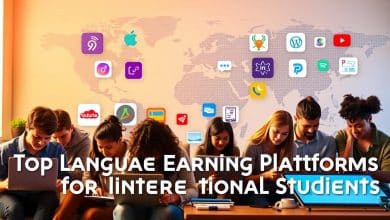Productivity Tools Every Student Should Use in 2025
Balancing coursework, deadlines, and digital distractions requires smart strategies in today’s fast-paced educational environment. Recent studies reveal that learners who adopt specialized applications see a 20% boost in study effectiveness. Nearly 80% report better time management when using these solutions.
From organizing notes to collaborating on group projects, the right digital resources can transform how learners approach their goals. The current market offers countless options tailored to different needs—whether prioritizing task tracking, file storage, or focused work sessions.
This guide highlights evidence-backed applications that simplify academic workflows. Each recommendation focuses on practical features that adapt to individual routines while supporting long-term success. Solutions range from intuitive planners to cloud-based platforms designed for seamless teamwork.
Choosing the best options depends on personal preferences and specific challenges. Some apps excel at breaking large projects into manageable steps, while others minimize distractions during study hours. The key lies in building a customized system that grows with evolving academic demands.
Introduction: Boosting Academic Success with Digital Tools
Today’s learners face evolving challenges that demand innovative solutions. Academic workloads now blend research, collaboration, and tight schedules—all requiring smarter approaches. Recent data shows those using specialized apps achieve 20% higher efficiency in their study routines. Even better, 80% find these solutions help reclaim valuable hours previously lost to disorganization.
Modern platforms go beyond basic calendars. They adapt to individual workflows, offering features like:
- Real-time sync across devices
- Offline access for uninterrupted work
- Team project dashboards
Choosing the right apps matters. The best ones feel like natural extensions of existing habits rather than complicated add-ons. They grow with users, scaling from simple note-taking to managing multi-phase assignments. This flexibility makes them essential for long-term academic progress.
Investing time to master these resources pays off. Learners develop skills that translate beyond classrooms—organized thinking, deadline management, and collaborative problem-solving. As educational demands shift, having a tailored digital toolkit becomes non-negotiable for staying competitive.
Understanding the Role of Productivity Apps in Student Life
Modern education demands more than textbooks and notebooks. Juggling lectures, assignments, and personal commitments creates a maze of responsibilities. Digital apps act as navigational aids, turning chaotic schedules into structured systems.
These platforms excel at automating repetitive work. Automatic reminders for deadlines, sync across phones and laptops, and shared project boards keep everything in one place. Instead of flipping through planners, learners access real-time updates with a tap.
| Traditional Methods | App-Based Solutions |
|---|---|
| Handwritten to-do lists | Smart task prioritization |
| Paper calendars | Auto-synced schedules |
| Email chains for group work | Instant collaboration features |
| Physical file storage | Cloud-based document management |
Effective workflow design matters. Apps reduce mental clutter by breaking large projects into smaller steps. This approach helps avoid last-minute rushes before exams or submissions.
Communication improves too. Shared dashboards let peers coordinate without endless messages. Professors appreciate organized submission histories during grade reviews.
Choosing the right apps depends on individual needs. Some prioritize time blocking, while others focus on note organization. The goal remains the same: creating systems that support academic growth without adding stress.
Key Features to Look For in Productivity Tools
In 2025, academic success increasingly depends on leveraging app capabilities tailored for dynamic learning environments. Core functionalities determine whether digital solutions enhance efficiency or become forgotten downloads. Prioritizing these elements helps build systems that adapt to both individual workflows and collaborative demands.
Essential App Capabilities and Integrations
Seamless synchronization across devices ensures materials stay updated whether accessed from phones, tablets, or laptops. Platforms that integrate with virtual classrooms and cloud storage eliminate switching between multiple tabs. Look for interfaces that feel intuitive within 10 minutes of use—complicated layouts often lead to abandoned subscriptions.
Offline functionality proves vital for learners commuting between campuses or working in areas with spotty Wi-Fi. Collaboration features should allow simultaneous editing, comment threads, and version histories to prevent group project chaos.
Pricing Structures and Free vs. Premium Options
Many applications offer free tiers with core features. One popular platform provides a Basic version supporting 25MB files and 10 annual assignments. Its Pro upgrade ($12/month) increases limits to 500MB files and unlimited tasks—ideal for thesis work or media-heavy projects.
When evaluating paid options, consider how often premium tools get used. A $8/month subscription pays off if it saves four hours weekly, but becomes wasteful for occasional users. Most providers offer annual discounts, reducing long-term costs by 20-30%.
Must-Have Productivity Tools Students Rely On
Academic workloads now demand solutions that merge efficiency with adaptability. Four core categories dominate modern digital strategies: organization systems, collaborative platforms, content creators, and focus enhancers. These applications form interconnected ecosystems rather than standalone fixes.
Cloud-based file sync services act as safety nets. They automatically back up essays and research while letting users retrieve materials from any device. One popular platform offers version history tracking—a lifesaver when edits go wrong.
Advanced note-taking tools now handle diagrams, audio clips, and PDF markups. “The best apps adapt to how you think, not the other way around,” notes a 2024 EdTech report. Search functions that scan handwritten text or lecture recordings save hours during exam prep.
Task managers break semesters into weekly goals. Color-coded dashboards show progress across group projects and solo assignments. Some platforms integrate with email calendars to auto-prioritize deadlines.
“Top performers use 40% fewer apps but master them thoroughly.”
Communication tools with built-in document editing reduce app-switching fatigue. Real-time co-editing features prevent version conflicts during team submissions. The key lies in choosing platforms that access multiple needs without cluttering workflows.
Ultimately, the right mix depends on individual rhythms. A biology major might prioritize data visualization tools, while a literature student needs robust citation managers. Regular audits help eliminate redundant apps—quality over quantity wins.
Top Organization Apps for Managing Files and Notes
Organizing academic materials efficiently separates thriving learners from those overwhelmed by digital clutter. Modern platforms transform chaotic workflows into structured systems, whether handling lecture recordings or group project drafts. The right combination of sync capabilities and intuitive interfaces keeps critical resources accessible—even offline.
Cloud Sync and Backup Solutions
Reliable cloud services prevent panic when devices fail or deadlines loom. Google Drive stands out with tiered storage plans starting at $1.99/month for 100GB. Its Backup and Sync feature maintains separate folders per device while unifying access through any browser. Key advantages include:
- Automatic version history for recovering lost edits
- Cross-platform availability on iOS, Android, and desktop
- Budget-friendly 2TB option at $9.99/month for media-heavy projects
Note-Taking and Document Management
Advanced apps now merge handwritten ideas with typed text seamlessly. GoodNotes lets users annotate PDFs while offering spellcheck and word prediction—features once exclusive to word processors. A single notebook can contain sketches, audio clips, and formatted documents.
Its $9.99 annual subscription includes:
- Unlimited pages for semester-long courses
- Instant search across handwritten and typed content
- Collaborative markup tools for peer reviews
These solutions reduce time spent reorganizing files, letting learners focus on mastering material rather than managing it.
Time Management and Focus-Enhancing Applications
Maintaining concentration during study sessions has become critical in our distraction-heavy digital age. Specialized applications now help structure time effectively while building mental stamina. These solutions blend proven techniques with modern tech to create personalized systems for academic success.
Pomodoro Timers and Distraction Blockers
The Pomodoro Technique splits work into 25-minute intervals followed by short breaks. While effective, its success hinges on resisting temptations like social media or gaming websites. Apps like Cold Turkey enforce these boundaries by blocking access to specified platforms during focus periods.
Forest takes a creative approach. Starting a session plants a virtual tree that grows only if you avoid phone use. Kill the tree by exiting early—a visual reminder to stay committed. This gamification process turns discipline into an engaging challenge.
Tracking Hours and Workflow Analysis
Understanding how time gets spent reveals improvement opportunities. Tracking apps record study durations and break frequencies. Over weeks, patterns emerge showing peak focus hours or recurring distractions.
Some platforms generate reports comparing planned vs. actual work time. This data helps adjust schedules for better efficiency. Pairing trackers with blockers creates accountability—users see exactly when they strayed to blocked websites.
Consistent use builds sustainable habits. As one user notes: “Watching my virtual forest grow keeps me motivated to protect those time blocks.” The right combination turns fleeting concentration into lasting academic progress.
Project and Task Management Solutions for Academic Success
Managing academic projects efficiently requires systems that adapt to shifting priorities and overlapping deadlines. Digital solutions streamline this process by converting scattered responsibilities into actionable steps. They minimize last-minute scrambles while maintaining clarity across multiple courses.
Digital To-Do Lists and Task Automation
Todoist simplifies capturing assignments through natural language commands. Typing “Read chapter 5 by Thursday 8pm” instantly creates a dated task. This eliminates manual calendar entries, preserving mental energy for actual work.
| Feature | Todoist | ClickUp |
|---|---|---|
| Recurring tasks | Auto-schedules via text input | Custom repeat intervals |
| Collaboration | Shared project boards | Live document editing + chat |
| Integration | Syncs with Google Calendar | Embeds spreadsheets & email |
ClickUp merges lists, wikis, and calendars into one dashboard. Its email integration lets users convert messages into tracked tasks without switching apps. Automated reminders escalate urgency as deadlines approach.
Advanced automation handles routine academic work. Set templates for weekly lab reports or monthly literature reviews. These systems learn patterns, suggesting optimizations for future project timelines.
Group management becomes transparent with shared progress trackers. Each member sees assigned deliverables while instructors monitor overall momentum. Adjust priorities instantly when unexpected changes disrupt original plans.
Enhancing Collaboration and Streamlining Group Projects
Teamwork often determines academic outcomes, yet coordinating schedules and merging ideas remains challenging. Modern platforms bridge this gap by combining communication and resource-sharing in unified spaces. This integration keeps groups aligned from brainstorming to final submissions.
Tools for Seamless Communication and File Sharing
Slack organizes discussions through topic-specific channels, letting users separate class debates from project logistics. Direct messages handle quick queries without cluttering group feeds. All conversations remain searchable, preserving context for latecomers joining mid-semester.
Zoom’s reliable video calls maintain clarity during complex collaboration. Its stable connection handles screen-sharing of dense research papers or multimedia presentations. Breakout rooms facilitate smaller team huddles within larger meetings.
File-sharing apps like Google Workspace eliminate version chaos. Multiple editors can tweak documents simultaneously while tracking changes. Comments resolve conflicts faster than endless email threads.
Simple interfaces ensure all members contribute equally, regardless of tech skills. When platforms work intuitively, groups spend less time troubleshooting and more time refining projects. The right mix turns fragmented efforts into cohesive results.
FAQ
What features make an app suitable for academic workflows?
Are free versions of apps sufficient for managing coursework?
Which apps help balance group project tasks effectively?
How can students minimize distractions during study sessions?
What’s the best way to organize research materials digitally?
Do any tools automate repetitive tasks like reminders?
Published on: 20 de August de 2025







